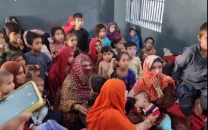Growing polio challenge
The eradication of polio is a communal responsibility

The Tank district of Khyber-Pakhtunkhwa has reported yet another case of the wild poliovirus, bringing the total tally of cases this year to 24. But the recorded number on paper does not always reflect reality within communities. According to the WHO, up to 90% of people infected with the virus remain asymptomatic, meaning they experience no symptoms or only mild ones including fever, flu and a sore throat. And all of these symptoms are typical of a common cold, and thus easily ignored.
Amongst delays in immunisation efforts as well as cultural and religious myths that deter families from getting their children vaccinated, another invisible danger lurking in the periphery is unsafe water and neglected sanitation. Since the virus lives in the intestines of an infected patient and is shed through stool, inadequate sanitation keeps fuelling the spread of the virus, putting zero-dose children and those who have not completed their recommended vaccination schedule at high risk.
This remains a central reason for why southern K-P has reported its 14th case of the year. The Pakistan Polio Eradication Programme therefore executes environmental (sewage) surveillance for the poliovirus across the country. According to the results for June 2025, of the 102 samples collected from 69 districts, 30 tested positive. And out of 16 processed samples from K-P, four tested positive.
The eradication of polio is a communal responsibility. It demands consistent vaccination campaigns across all provinces, but especially those with higher risks - regions where dense populations, unsafe water, poor sanitation and a deeply embedded mistrust of healthcare workers allow the virus to survive and spread. Secure and consistent polio campaigns amidst hostilities against polio staff are commendable, but until there are no zero-dose children there is still urgent work to be done.















COMMENTS
Comments are moderated and generally will be posted if they are on-topic and not abusive.
For more information, please see our Comments FAQ